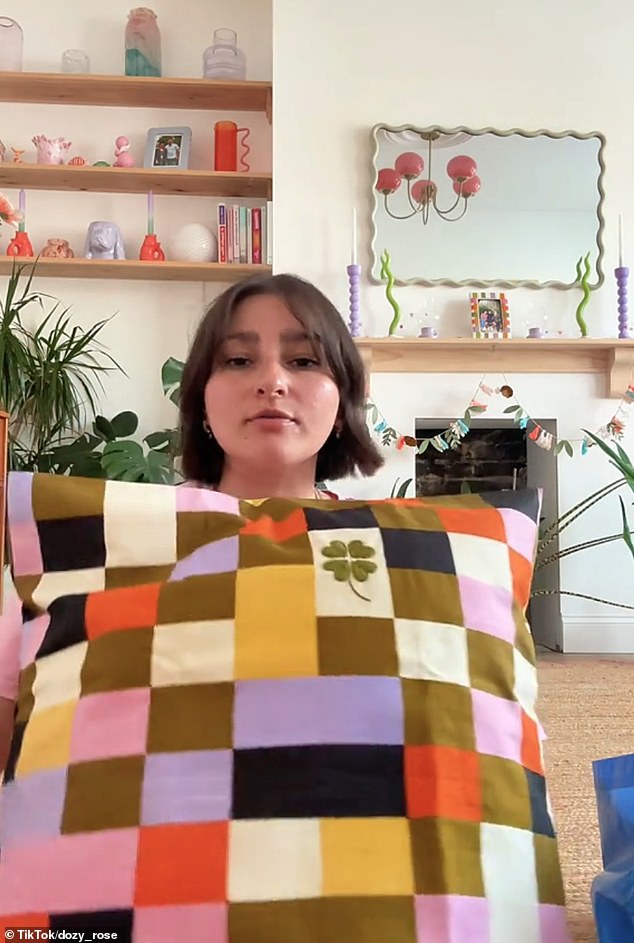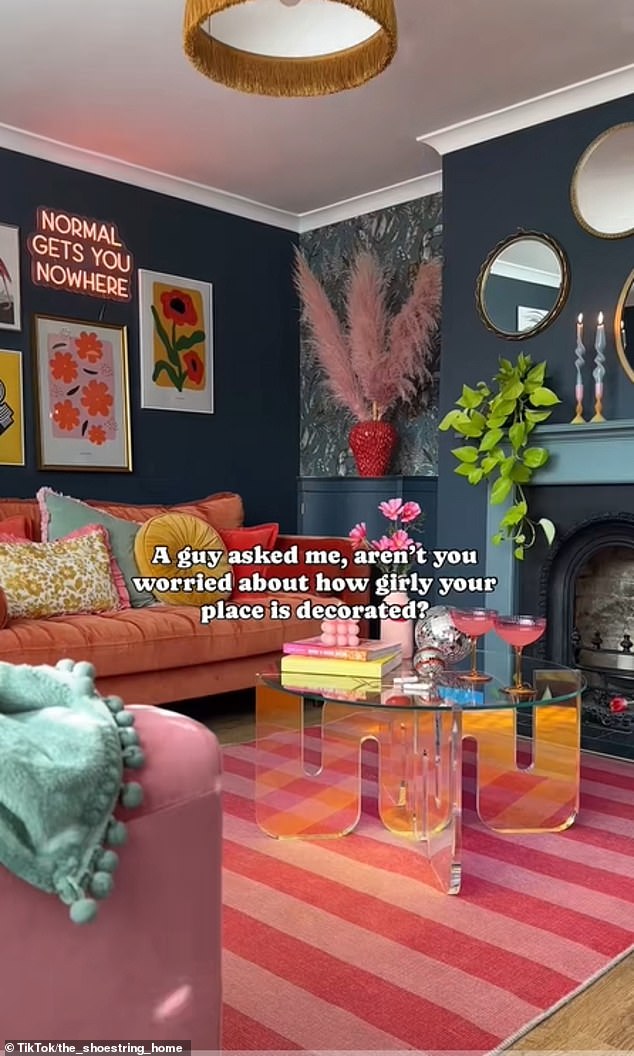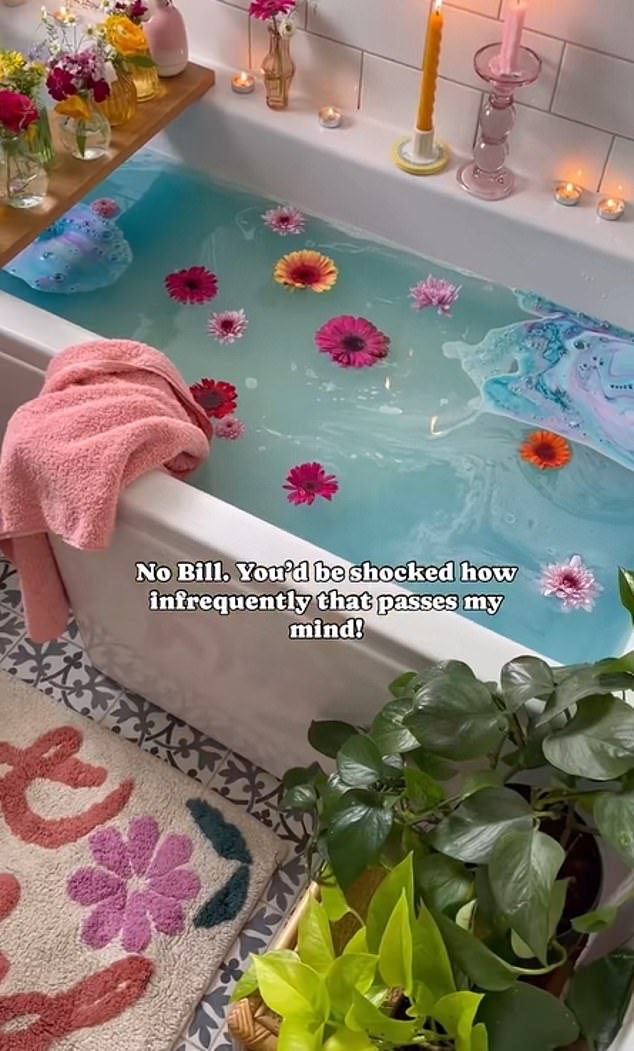Daily Mail journalists select and curate the products that feature on our site. If you make a purchase via links on this page we will earn commission – learn more
Young homeowners are ditching drab designs and sterile settings to embrace a new trend – dopamine décor.
Named for its mood-enhancing properties, dopamine décor is the latest in interior design trends, and Gen Z British homeowners are rushing to adorn their rooms with stimulating colours, playful patterns, and unique textures.
The trend, which has more than 34 million posts to its name on TikTok, follows the social media trend of ‘dopamine dressing’, which inspired people to dress in a way that boosts their mood.
Rather than promoting a specific aesthetic, dopamine décor places greater emphasis on personal pleasure, encouraging people to beautify their homes in whatever way inspires joy in them.
Interior expert Monika Puccio, director of buying at Sofa Club told DailyMail: ‘At its heart, the dopamine décor trend is about creating joy through your surroundings.’
One of the trend’s biggest champions, Kimberley Walsh, is even getting in on the action by brushing her walls with pretty pastels.
‘I’m loving dopamine décor – adding warm pastel colours like this to boost happiness and positivity in my family spaces,’ she said.
She’s so passionate about the trend, that she recently launched a shade new shade of pastel pink paint with Wickes.

Young homeowners are ditching drab and designs and sterile settings to embrace a new interior trend – dopamine décor

One of the trend’s biggest champions, Kimberley Walsh (pictured) is even getting in on the action by brushing her walls with pretty pastels
The new shade, called Blush Rose, launched on July 3, retailing at £14 per 2.5L. It joined the brand’s existing hues, Blue Haze and Subtle Sage.
‘I’ve always had a soft spot for dusty, vintage pinks – they’re already a big part of my own home,’ said Walsh.
‘It’s a colour that lifts the mood instantly, bringing little sparks of joy and a burst of energy to any space,’ she added, explaining that the invention of Blush Rose had been inspired by dopamine décor.
The 43-year-old emphasised the need to create a home that is ‘playful, energising, and full of life’.
Blush Rose is a very gentle and calming colour of paint that can work well in any room as it responds elegantly to the light around it. With its quiet beauty, Blush Rose is a flawless paint choice if you’re looking to create an airy and relaxing space.
Subtle Sage is a tranquil hue, drawing on inspiration from the soothing tones found in nature’s greenery. Intended to be a versatile colour, Subtle Sage perfectly blends and complements other natural neutral earthy tones to create tonal harmony. It is also able to stand up to more striking bolder colours for contrast and to make a statement.
Blue Haze is a very gentle and calming colour of paint that can work well in any room as it responds elegantly to the light around it. With its quiet beauty, Blue Haze is a flawless paint choice if you’re looking to create an airy and relaxing space.
Indeed, pink has become this summer’s seasonal choice, with over 32,000 videos for ‘pink decor’ on TikTok, the home of thousands of aspirational Gen Z interior designers.
The reason dopamine decor has become so popular is largely down to its core properties which are inherently designed to make people feel good.
Research by neurobiologists Semir Zeki and Tomohiro Ishizu showed that when people look at aesthetically pleasing art, their reward centres light up.
And it’s the same area that is activated when people experience feeling of being in love.

Named for it’s mood enhancing properties, dopamine décor is the latest in interior design trends – with Gen Z British homeowners now rushing to adorn their rooms with stimulating colours, playful patterns, and unique textures

Rather than instructing its proponents to adhere to a certain aesthetic, dopamine décor places greater emphasis on personal pleasure, encouraging people to beautify their homes with whatever inspires joy in them
However – they said it isn’t just dopamine that is activated, but that a complicated mixture of neurotransmitters are activated.
Those include serotonin for mood regulation, oxytocin for feelings of comfort and belonging, norepinephrine for excitement, and endorphins for overall well-being.
Other studies have shown that bold and vibrant spaces give way to a better sensory experience in other areas, so even enjoying a good book or a box of chocolates feels better in a joy inducing room.
This, which is called cross-modal perception, has been studied extensively at Oxford’s Crossmodal Lab.
The research shows that the brain’s interpretation of one sense can drastically impact how people experience other senses.
As Puccio pointed out, the trend ‘draws on the idea that colour, texture, and pattern can have a tangible effect on our mood.

Research by neurobiologists Semir Zeki and Tomohiro Ishizu showed that when people look at aesthetically pleasing art, their reward centres light up
‘Certain shades stimulate positive emotional responses, while playful combinations remind us of creativity and freedom.
‘Just as dopamine is known as the ‘feel-good’ neurotransmitter, this trend taps into the power of design to uplift and energise us in our daily lives.’
The dopamine driven trend is providing a welcome to relief to ‘years of muted, minimalist interiors,’ the design expert said.
Additionally, as the population navigates a period of global uncertainty, many are looking for solace in other walks of life – like in their homes.
Puccio said: ‘People are craving optimism and self-expression in their homes, whether that’s through bold statement furniture, vibrant colour pops, or unexpected pairings.
‘It’s a way of bringing personality and a sense of fun back into design, creating spaces that don’t just look stylish but genuinely make you feel good to live in.’
The trendy design method is also accessible as it isn’t rule-based. Rather, the only instruction to homeowners is to fill their walls with mood elevating colours and furniture.
‘We’re noticing that customers are becoming less concerned with rules and more focused on how their interiors make them feel.
‘That’s what makes dopamine décor so powerful, it’s a celebration of individuality, joy, and the emotional connection we all have with our homes,’ she said.















